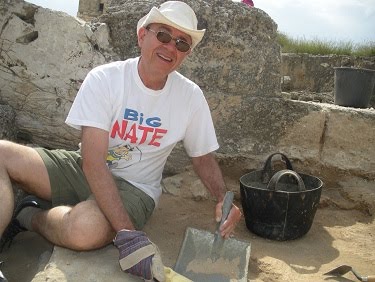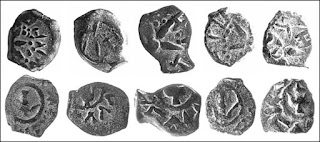Every year at Christmas time, folks have questions about the
“poor widow’s mites” made famous by the story in Mark 12:41-44 and Luke 21:1-4.
And Jesus sat over against the treasury, and
beheld how the people cast money into the treasury: and many that were rich
cast in much. And there came a certain poor widow, and she threw in two mites (λεπτόν), which make a farthing (κοδράντης). And he called unto him his disciples, and
saith unto them, Verily I say unto you, That this poor widow hath cast more in,
than all they which have cast into the treasury: For all they did cast in of their
abundance; but she of her want did cast in all that she had…
The word “mite” first appears in
the books of Mark and Luke in the 1525 first publication of Tyndale’s New Testament, where it was likely
intended as a shortened version of the word “minute” (as in very small) and not
as the name of a denomination. As the late Fr. A. Spijkerman has noted, the
word lepton “implies very small
coins…even we may say...the smallest coin being in circulation in Palestine at
the time concerned.”
It is not surprising that scholars
who did early English translations of the Bible had a tendency to “reinterpret
the ancient coin denominations of the Greek, Latin, and Hebrew scriptural
sources in terms of contemporary sixteenth- and seventeenth-century English
money,” according to Oliver Hoover, who discussed this in detail in the ANS Magazine, 2006, 2, and points out
that neither the original Greek text of the New Testament nor the Latin Vulgate
Bible, mention the “mite.” Instead the Greek or Latin words used in that
version are either lepta or minuta respectively.
The word
“mite” was most widely disbursed by the King James Version, printed in 1611,
after work by 47 scholars that lasted nearly seven years. “Not only would this
translation become one of the most popular English versions of the Bible ever
published, but the artistry of its language ensured that it would also become
one of the greatest single influences on the development of English literature
well into the twentieth century,” Hoover said.
The
translators wished their work to “speak like itself, as in the language of
Canaan, that it may be understood even of the very vulgar.” For this reason,
the King James Bible and some earlier English translations are of “some
interest to numismatists, given their tendency to reinterpret the ancient coin
denominations of the Greek, Latin, and Hebrew scriptural sources in terms of
contemporary sixteenth and seventeenth-century English money. Thus, in a small
way, the King James Version serves as a document for the circulating coinage of
early modern Great Britain,” Hoover wrote.
However,
there was no mite coin known to exist
in British coinage of this period. “In fact, the mite (meaning “small cut piece” in Old Dutch) was only created as a
circulating coin of Flanders in the fourteenth
century. Initially, the mite was a
small billon [very low quality silver] coin...but by the sixteenth century it had become copper,” he explained.
One might
guess, therefore, that this denomination was imported and used in Britain at
the time, but “there is little evidence to support this possibility,” Hoover wrote.
Even though the Dutch mite did not circulate in Britain, and no British mites existed, the mite was mentioned in sixteenth-century arithmetic books as a
fraction of a farthing, varying from
one-third to one-sixteenth.
It seems
quite “likely that the mite has entered into the King James Version…as a result
of a translational quandary created by the original…”
In these
early versions, Mark gives the value of two lepta
as a kodrantes or quadrans. But Hoover pinpoints the
crunch: while “any Latin grammarian would have known that a quadrans was a bronze coin worth
one-fourth of a Roman as, making its
English translation as farthing
(one-fourth of a penny) almost
unavoidable. Unfortunately, in the English coinage system there were no
denominations smaller than a farthing,
creating the problem of how to deal with Mark’s lepta/minuta.”
Thus there
was no British parallel for any coin smaller than a farthing, and there is a good chance that the arithmetic term mite was thus brought into play. Hoover
also speculates, however, that possibly William Tyndale’s pre-King James
translation might “have been a little influenced by the contemporary Flemish
monetary system when he chose his words. After all, Tyndale is known to have
had good Flemish connections, and he composed and printed his translation of
the New Testament while in the nearby German cities of Hamburg , Cologne , and Worms . In 1534, Antwerp became his home and a base for
shipping his contraband translations into Tudor England, until he was finally
arrested and executed for heresy in 1536. Thus, Tyndale is likely to have been
conversant with the Flemish currency system, in which there were twenty-four mites to the penning.”
Later, during the seventeenth century British money had not been
decimalized and was organized according the pound/shilling/pence system. There were 240 pence
(pennies) to the pound. There were smaller denominations than the penny, such as the farthing, which was one-quarter of a penny. There was an even smaller coin, worth a half-farthing, and it was called a mite. Hence, the smallest coin in
circulation in early first century Jerusalem, became known worldwide and
probably for all time as the mite.
It is logical that people who are
interested in the stories of the Bible would want to know more about these
coins and exactly which ones could be associated with the stories.
Frederick Madden, in 1864, wrote
that “The mite…was the smallest coin
current in Palestine in the time of our Lord.”
In 1914, Rogers wrote that “it is
natural to conclude that the coins being cast into the treasury were strictly
Jewish coins….the choice of strictly Jewish copper is accordingly limited to
the coins of the Hasmonean or the Herodian families….and with some degree of
certainty it may be said that the popular coins for this purpose were the small
copper of Alexander Jannaeus and his successors…”
Whatever its origin, the poor
widow’s mite has become one of the
most frequently referenced and most popular ancient biblical coins.
Here are two things we know about the widow’s mite story, as related by both Mark and Luke:
-- It is certainly a story about
charity and goodwill, rather than a story about money. The poor woman gave all
she had to the treasury of the Jewish Temple in Jerusalem, while, relatively
speaking, many rich people gave little of themselves.
-- The amount of money the widow
threw into the Temple treasury was two coins of the smallest size in existence
in Jerusalem at that time. There is no doubt that the small prutah (Guide to Biblical Coins (GBC)
Nos. 1152, 1153) or half-prutah (GBC Nos. 1134, 1138, 1147, 1185-87),
coins of the Maccabean kings and Herod the Great, fit that description. The
most common among them, easily by a factor of more than 1000 to 1, is the small
prutah that was most likely struck by
the Hasmonean successors of King Alexander Jannaeus (103 – 76 BC), which have
been documented to range in weight from 0.20 to 1.70 grams, with an average of
0.81 grams.
The massive issue of these tiny
bronze coins in this poor land filled a market need. Some versions of these
coins may have been first struck very late in Jannaeus’ reign and likely
continued to be minted periodically until as last as 50-45 BC. These coins were
all decorated on one side with an anchor and on the other side a crude star.
Herod I (40 – 37 BC) also minted
very similar looking coins but much more scarce coins, possibly quite early in
his reign, which technically began on the ground in Judea around 37 BC, these
coins range in weight from 0.49 grams to 1.78 grams with an average of 0.94
grams. Herod’s coins are decorated on one side with an anchor and on the other
side a crude inscription.
The similarities of the Herodian to
the Hasmonean in both design and method and general appearance coins suggest
that the latter were crudely copied from the earlier ones, and archaeological
finds suggest that their circulation overlapped.
PHOTO: Similarities between
Hasmonean small prutot (GBC 1153, top 2 rows) and the slightly later Herodian
small prutot (GBC 1173 – 1177 bottom 2 rows). Photo Copyright © 2010 by David
Hendin
Both the Hasmoneans and Herod I also issued relatively small numbers of a
few coin types which were clearly meant to be half denomination prutot.
The best current evidence suggests
that during the first century, the Judean shekel
was made up of 256 prutot. Consider
that there are 100 cents to the dollar; hence this was very small change
indeed. In those days one pomegranate cost only a prutah and in those days many pomegranates grew wild and could be
plucked off trees in many areas (as they can today in Israel) for free.
Archaeological evidence proves that
even though these small coins were struck in the first century BC, they continued
to circulate well into the first century AD when Jesus lived, and even for as
long as the fourth century AD. This has been shown by archaeological
excavations in Israel. At the Joint Sepphoris excavation in 1985, we found the
small prutot of Jannaeus in the same
areas as fourth-century Roman bronze coins. These were useful pieces of small
change, at a time and place that small change was not easy to find (many late
Roman and Byzantine small bronze coins were chopped in halves and quarters to
accommodate the market need).
Another aspect of the story of the
poor widow’s mite remains relevant today: Many people of great means contribute
little to charitable causes, while less wealthy individuals contribute a great
deal relative to their ability. This is a topic fit for everyone to ponder.
Copyright © by
David Hendin
(Adapted from Guide to
Biblical Coins, 5th Edition)


